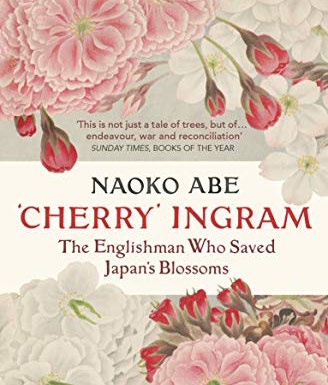From Living Woods issue 56
ANTONY MASON, co-ordinator of the Woodlands Awards, explains why he was particularly struck by one of last year’s winners
 ‘CHERRY’ INGRAM – THE ENGLISHMAN WHO SAVED JAPAN’S BLOSSOMS
‘CHERRY’ INGRAM – THE ENGLISHMAN WHO SAVED JAPAN’S BLOSSOMS
Naoko Abe
Chatto & Windus
400 pages 150 x 220mm
Hardback £18.99
Paperback £10.99
The subject of this book touches us all. Who hasn’t stood in enchanted wonder before an ornamental cherry tree, in a street, in a park or garden, even sometimes in woodlands? Flowering cherries are now common enough in the UK, but have only been so for the last century or so – and that is largely down to the work of one avid enthusiast and collector, Collingwood ‘Cherry’ Ingram (1880–1981).
Not only this but, as the book’s subtitle proposes, he was ‘The Englishman Who Saved Japan’s Blossoms’. Having collected every variety he could lay his hands on, and grown some 120 of them on his estate in Benenden, in Kent, he possessed a unique archive of flowering cherries. This became particularly precious to Japan.
Once the unique source of sakura ornamental flowering cherry species, Japan had a historic reverence for cherry blossom, as witnessed in the annual spring passion for hanami (cherry-blossom viewing). Flowering cherry varieties were avidly collected, and protected by the venerable sakuramori (cherry guardians). But from around 1900 Japan pursued virtually a cherry monoculture when the blossom became the object of imperialist symbolism, favouring the pink, fast-growing Somei-yoshino hybrid above all others, and neglecting – even uprooting and replacing – the rest.
The symbolism turned sinister when falling cherry blossom petals were poetically associated with kamikaze pilots. This is a beautifully illustrated book, with drawings of various flowering cherries, and evocative photographs of ‘Cherry’ Ingram at home and on his travels in Japan – but none perhaps is more poignant than the photograph of Japanese girls lined up on an airstrip to bid farewell to kamikaze pilots by waving fronds of cherry blossom at their departing planes.
After the Second World War, ‘Cherry’ Ingram (who died in 1981, at the age of 100) was able to help restore to a recovering Japan many of the varieties that had been lost during the preceding decades. Some of these, but for him, might well have become extinct.
Naoko Abe, a Japanese journalist and non-fiction writer living in London since 2001, is superbly well placed to tell this story. She fully understands the British side of it: how a somewhat eccentric, independently wealthy young man (Ingram’s publisher-grandfather founded the Illustrated London News) falls to an all-consuming passion, and how that is seen in his own social milieu. More, she is able to give an account of 20th-century history from a Japanese perspective, with all the explanation needed to be accessible to English-language readers. This makes for some brutally uncomfortable reading, as in the story behind that unsettling kamikaze photograph.
Naoko Abe’s book is thus a rich blend: the enthusiasm for trees, botanical research, family history, two contrasting cultures, and world war – with a satisfying sense of redemption achieved by the innocent passions of good people. Read this book, and next spring you will gaze upon a flowering cherry tree through a new lens – and with an even greater sense of wonder.